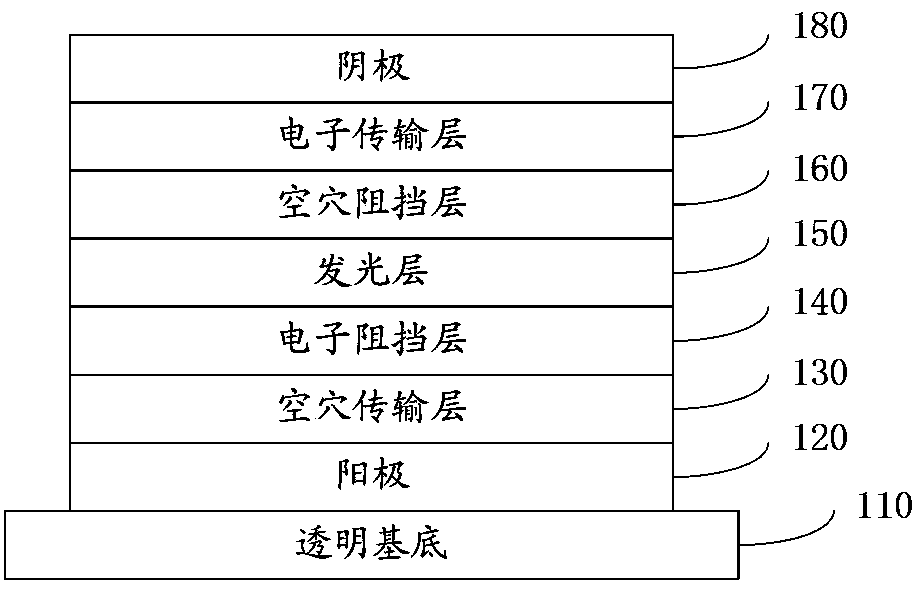Organic light-emitting device and preparation method thereof
An electroluminescent device and luminescent technology, which is applied in the fields of electric solid-state devices, semiconductor/solid-state device manufacturing, electrical components, etc., can solve problems such as poor blocking effect, small size of alkali metal ions, and exciton quenching
- Summary
- Abstract
- Description
- Claims
- Application Information
AI Technical Summary
Problems solved by technology
Method used
Image
Examples
preparation example Construction
[0065] Such as figure 2 The preparation method of the above-mentioned organic electroluminescence device shown, comprises the following steps:
[0066] S10 , providing a clean transparent substrate 110 .
[0067] The transparent substrate 110 can be common glass. The transparent substrate 110 was ultrasonically cleaned in deionized water containing detergent, and then ultrasonically treated in isopropanol and acetone for 20 minutes, and then dried with nitrogen to obtain a clean transparent substrate 110 .
[0068] S20, forming an anode 120 on the transparent substrate 110 obtained in S10.
[0069] The anode 120 is formed on the transparent substrate 110 by magnetron sputtering system.
[0070] The anode 120 can be an ITO thin film or an AZO thin film, and the thickness can be 70nm~200nm.
[0071] S20 also includes the operation of placing the transparent substrate 110 formed with the anode 120 in a plasma processing chamber for plasma processing. Performing plasma treatme...
Embodiment 1
[0095] The transparent substrate was ultrasonically cleaned in deionized water containing detergent. After cleaning, it was ultrasonically treated in isopropanol and acetone for 20 min, and then dried with nitrogen to obtain a clean transparent substrate.
[0096] The anode is formed on the transparent substrate by magnetron sputtering, the material of the anode is AZO, and the thickness of the anode is 70nm. The transparent substrate formed with the anode is placed in a plasma treatment chamber for plasma treatment.
[0097] In a vacuum of 5 x 10 -4 In the vacuum coating system of Pa, a hole transport layer with a thickness of 60nm is formed on the anode by evaporation. The material of the hole transport layer is MeO-TPD doped with F6-TNAP. F6-TNAP accounts for the mass of the hole transport layer. The percentage is 5%.
[0098] In a vacuum of 5 x 10 -4 In Pa's vacuum coating system, an electron blocking layer with a thickness of 5nm is evaporated on the hole transport layer...
Embodiment 2
[0106] The transparent substrate was ultrasonically cleaned in deionized water containing detergent. After cleaning, it was ultrasonically treated in isopropanol and acetone for 20 min, and then dried with nitrogen to obtain a clean transparent substrate.
[0107] The anode is formed on the transparent substrate by magnetron sputtering, the material of the anode is ITO, and the thickness of the anode is 100 nm. The transparent substrate formed with the anode is placed in a plasma treatment chamber for plasma treatment.
[0108] In a vacuum of 5 x 10 -4 In the vacuum coating system of Pa, a hole transport layer with a thickness of 60nm is formed on the anode by evaporation. The material of the hole transport layer is MeO-TPD doped with F6-TNAP. F6-TNAP accounts for the mass of the hole transport layer. The percentage is 5%.
[0109] In a vacuum of 5 x 10 -4 In Pa's vacuum coating system, an electron blocking layer with a thickness of 5nm is evaporated on the hole transport l...
PUM
 Login to View More
Login to View More Abstract
Description
Claims
Application Information
 Login to View More
Login to View More - R&D
- Intellectual Property
- Life Sciences
- Materials
- Tech Scout
- Unparalleled Data Quality
- Higher Quality Content
- 60% Fewer Hallucinations
Browse by: Latest US Patents, China's latest patents, Technical Efficacy Thesaurus, Application Domain, Technology Topic, Popular Technical Reports.
© 2025 PatSnap. All rights reserved.Legal|Privacy policy|Modern Slavery Act Transparency Statement|Sitemap|About US| Contact US: help@patsnap.com



